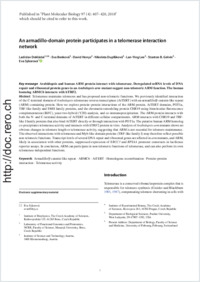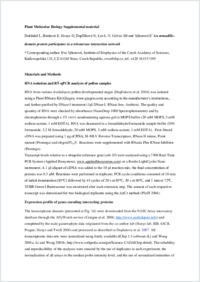An armadillo-domain protein participates in a telomerase interaction network
- Dokládal, Ladislav Institute of Biophysics, The Czech Academy of Sciences, Brno, Czech Republic - Laboratory of Functional Genomics and Proteomics, NCBR, Faculty of Science, Masaryk University, Brno, Czech Republic - Department of Biology, Faculty of Science and Medicine, University of Fribourg, Switzerland
- Benková, Eva Institute of Science and Technology Austria, Klosterneuburg, Austria
- Honys, David Institute of Experimental BotanyThe Czech Academy of Sciences, Prague, Czech Republic
- Dupláková, Nikoleta Institute of Experimental BotanyThe Czech Academy of Sciences, Prague, Czech Republic
- Lee, Lan-Ying Department of Biological SciencesPurdue University, West Lafayette, USA
- Gelvin, Stanton B. Department of Biological SciencesPurdue University, West Lafayette, USA
- Sýkorová, Eva Institute of Biophysics, The Czech Academy of Sciences, Brno, Czech Republic
-
01.07.2018
Published in:
- Plant Molecular Biology. - 2018, vol. 97, no. 4, p. 407–420
English
Key messageArabidopsis and human ARM protein interact with telomerase. Deregulated mRNA levels of DNA repair and ribosomal protein genes in an Arabidopsis arm mutant suggest non-telomeric ARM function. The human homolog ARMC6 interacts with hTRF2.AbstractTelomerase maintains telomeres and has proposed non-telomeric functions. We previously identified interaction of the C- terminal domain of Arabidopsis telomerase reverse transcriptase (AtTERT) with an armadillo/β-catenin-like repeat (ARM) containing protein. Here we explore protein– protein interactions of the ARM protein, AtTERT domains, POT1a, TRF-like family and SMH family proteins, and the chromatin remodeling protein CHR19 using bimolecular fluorescence complementation (BiFC), yeast two-hybrid (Y2H) analysis, and co- immunoprecipitation. The ARM protein interacts with both the N- and C-terminal domains of AtTERT in different cellular compartments. ARM interacts with CHR19 and TRF-like I family proteins that also bind AtTERT directly or through interaction with POT1a. The putative human ARM homolog co-precipitates telomerase activity and interacts with hTRF2 protein in vitro. Analysis of Arabidopsis arm mutants shows no obvious changes in telomere length or telomerase activity, suggesting that ARM is not essential for telomere maintenance. The observed interactions with telomerase and Myb-like domain proteins (TRF-like family I) may therefore reflect possible non- telomeric functions. Transcript levels of several DNA repair and ribosomal genes are affected in arm mutants, and ARM, likely in association with other proteins, suppressed expression of XRCC3 and RPSAA promoter constructs in luciferase reporter assays. In conclusion, ARM can participate in non-telomeric functions of telomerase, and can also perform its own telomerase-independent functions.
- Faculty
- Faculté des sciences et de médecine
- Department
- Département de Biologie
- Language
-
- English
- Classification
- Biological sciences
- License
-
License undefined
- Identifiers
-
- RERO DOC 322805
- DOI 10.1007/s11103-018-0747-4
- Persistent URL
- https://folia.unifr.ch/unifr/documents/307377
Other files
Statistics
Document views: 108
File downloads:
- pdf: 265
- Supplementary material: 152
- Tab 1: 61
- Tab 2: 55


